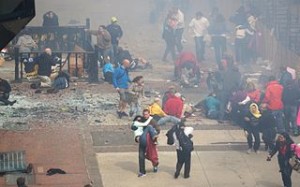
Marathon explosion scene (Aaron Tang/Wikimedia Commons)
The media has had a hard time reporting the search for a suspect in the Boston Marathon bombing since the explosions killed three and injured about 100 Monday. CNN and the Associated Press battled with NBC News on Twitter Wednesday morning, each news site claiming that authorities had either found a suspect or hadn’t. The New York Post reported on Monday that 12 people had been killed, citing a federal law enforcement source. In light of the media’s confusion, the Dart Center re-posted a compilation of advice they solicited from several journalists following the shootings in Tucson in 2012.
Editors, freelancers, broadcasters and international reporters shared different anecdotal lessons from covering various tragedies like the Oklahoma and Madrid bombings. Here are some highlights:
Scott Wallace, freelance journalist: “Above all, forget trying to ‘scoop’ your colleagues on this story.”
Steven Gorelick, professor of media studies at Hunter College: “Be very careful about the experts you select as sources. These kinds of high-profile stories are magnets for everyone from legitimate scholars and practitioners to self-proclaimed ‘profilers.'”
Lena Jakobsseon, TV producer: “Chasing victims’ family members down the street seems like a far more reasonable idea if CNN and MSNBC and FOX and all the nets are doing it, too, and you’re about to get yelled at if you don’t get that video. But you always have at least a few seconds to stop and listen to what your gut is telling you. Ratings come and go. The impact on your integrity, and on the people you’re covering — that stays.”










